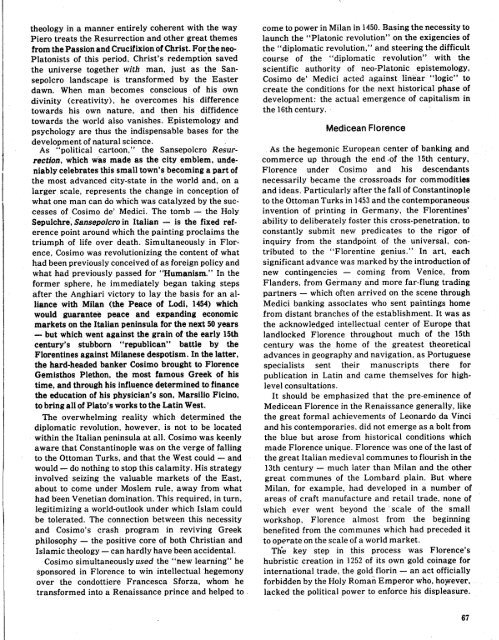Renaissance and
Renaissance and
Renaissance and
You also want an ePaper? Increase the reach of your titles
YUMPU automatically turns print PDFs into web optimized ePapers that Google loves.
theology in a manner entirely coherent with the way come to power in Milan in 1450. Basing the necessity to<br />
Piero treats the Resurrection <strong>and</strong> other great themes launch the "Platonic revolution" on the exigencies of<br />
from the Passion <strong>and</strong> Crucifixion of Christ. For the neo- the "diplomatic revolution," <strong>and</strong> steering the difficult<br />
Platonists of this period, Christ's redemption saved course of the "d!plomatic revolution" with the<br />
the universe together with man, just as the San- scientific authority of neo-Platonic epistemology,<br />
sepolcro l<strong>and</strong>scape is transformed by the Easter Cosimo de' Medici acted against linear "logic" to<br />
dawn. When man becomes conscious of his own create the conditions for the next historical phase of<br />
divinity (creativity), he overcomes his difference development: the actual emergence of capitalism in<br />
towards his own nature, <strong>and</strong> then his diffidence the l6thcentury.<br />
towards the world also vanishes. Epistemology <strong>and</strong><br />
psychology are thus the indispensable bases for the Medicean Florence<br />
development of natural science.<br />
As "political cartoon," the Sansepolcro Resur- As the hegemonic European center of banking <strong>and</strong><br />
rection, which was made as the city emblem, unde- commerce up through the end.of the 15th century,<br />
niablycelebrates this smalltown's becominga partof Florence under Cosimo <strong>and</strong> his descendants<br />
the most advanced city-state in the world <strong>and</strong>, on a necessarily became the crossroads for commodities<br />
larger scale, represents the change in conception of <strong>and</strong> ideas. Particularly after the fall of Constantinople<br />
what one man can do which was catalyzed by the suc- to the Ottoman Turks in 1453 <strong>and</strong> the contemporaneous<br />
cesses of Cosimo de' Medici. The tomb -- the Holy invention of printing in Germany, the Florentines'<br />
Sepulchre, Sansepolcro in Italian -- is the fixed ref- ability to deliberately foster this cross-penetration, to<br />
erence point around which the painting proclaims the constantly submit new predicates to the rigor of<br />
triumph of life over death. Simultaneously in Flor- inquiry from the st<strong>and</strong>point of the universal, conence,<br />
Cosimo was revolutionizing the content of what tributed to the "Florentine genius." In art, each<br />
had been previously conceived of as foreign policy <strong>and</strong> significant advance was marked by the introduction of<br />
What had previously passed for "Humanism." In the new contingencies -- coming from Venice, from<br />
former sphere, he immediately began taking steps Fl<strong>and</strong>ers, from Germany <strong>and</strong> more far-flung trading<br />
after the Anghiari victory to lay the basis for an al- partners -- which often arrived on the scene through<br />
liance with Milan (the Peace of Lodi, 1454) which Medici banking associates who sent paintings home<br />
would guarantee peace <strong>and</strong> exp<strong>and</strong>ing economic from distant branches of the establishment. It was as<br />
markets on the Italian peninsula for the next 50 years the acknowledged intellectual center of Europe that<br />
-- but which went against the grain of the early 15th l<strong>and</strong>locked Florence throughout much of the 15th<br />
century's stubborn "republican" battle by the century was the home of the greatest theoretical<br />
Florentines against Milanese despotism. In the latter, advances in geography <strong>and</strong> navigation, as Portuguese<br />
the hard-headed banker Cosimo brought to Florence specialists sent their manuscripts there for<br />
Gemisthos Plethon, the most famous Greek of his publication in Latin <strong>and</strong> came themselves for hightime,<br />
<strong>and</strong> through his influence determined to finance level consultations.<br />
the education of his physician's son, Marsilio Ficino, It should be emphasized that the pre-eminence of<br />
to bring all of Plato's works to the Latin West. Medicean Florence in the <strong>Renaissance</strong> generally, like<br />
The overwhelming reality which determined the the great formal achievements of Leonardo da Vinci<br />
diplomatic revolution, however, is not to be located <strong>and</strong> his contemporaries, did not emerge as a bolt from<br />
within the Italian peninsula at all. Cosimo was keenly the blue but arose from historical conditions which<br />
aware that Constantinople was on the verge of falling made Florence unique. Florence was one of the last of<br />
to the Ottoman Turks, <strong>and</strong> that the West could -- <strong>and</strong> the great Italian medieval communes to flourish in the<br />
would -- do nothing to stop this calamity. His strategy 13th century -- much later than Milan <strong>and</strong> the other<br />
involved seizing the valuable markets of the East, great communes of the Lombard plain. But where<br />
about to come under Moslem rule, away from what Milan, for example, had developed in a number of<br />
had been Venetian domination. This required, in turn, areas of craft manufacture <strong>and</strong> retail trade, none of<br />
legitimizing a world-outlook under which Islam could which ever went beyond the 'scale of the small<br />
be tolerated. The connection between this necessity workshop, Florence almost from the beginning<br />
<strong>and</strong> Cosimo's crash program in reviving Greek benefited from the communes which had preceded it<br />
philosophy -- the positive core of both Christian <strong>and</strong> to operate on the scale of a world market.<br />
Islamic theology--canhardlyhavebeenaccidental. The key step in this process was Florence's<br />
Cosimo simultaneously used the "new learning" he hubristic creation in 1252 of its own gold coinage for<br />
Sponsored in Florence to win intellectual hegemony international trade, the gold florin -- an act officially<br />
over the condottiere Francesca Sforza, whom he forbidden by the Holy Roman Emperor who, ho.wever,<br />
transformed into a <strong>Renaissance</strong> prince <strong>and</strong> helped to. lacked the political power to enforce his displeasure.<br />
67

















